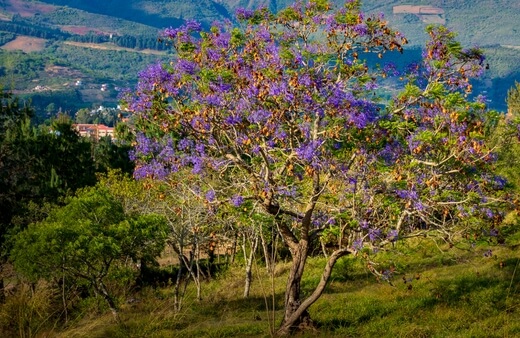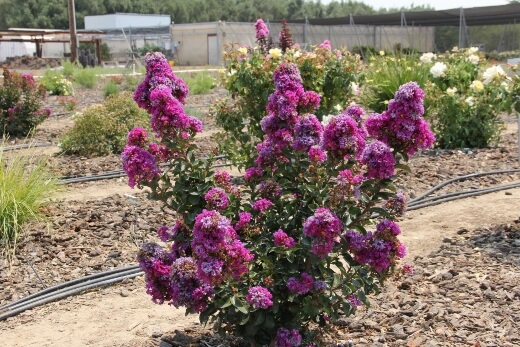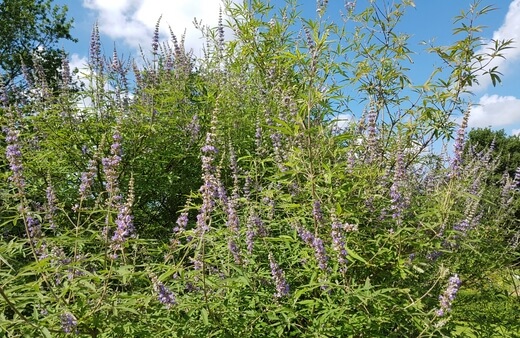Adored by locals and tourists alike, purple flowering trees mark the start of spring across Australia. The most famous of these is the Jacaranda tree, which grows the length of the country from Perth to Sydney.
But other ornamental trees that flower in striking shades of purple may be better suited to planting in private spaces. Whatever space you have, there is a beautiful tree for you.
More...
Popular Purple Flowering Trees in Australia
Jacaranda mimosifolia

The Jacaranda is undoubtedly the most commonly sighted purple flowering tree in Australia. An attractive purple haze appears across the country every spring as jacaranda trees bloom into colour.
Jacaranda trees are part of the family Bignoniaceae and boast long-lasting flowers in stunning shades of light purple. Most are grown from seed, which gives each one a unique appearance.
Jacaranda mimosifolia is a relatively fast-growing tree that reaches up to 50 ft in height and width, so they need plenty of room to grow. They flourish in full sun but will tolerate light shade, although the sunniest spot you can find is best for the most vibrant colour.
Not only does a jacaranda tree look spectacular in full bloom, but it also makes the ground appealing by leaving an attractive carpet of purple petals as the flowers drop from the trees.
However, the blooms aren't welcomed by everyone, with students at the University of Queensland experiencing 'purple panic' as exam season begins.
Jacaranda trees are a common sight across Australia, but for a truly spectacular display, some areas are better than others. A wander around New Farm Park in Brisbane is a pleasant way to take in the beauty of these colourful trees.
Alternatively, head to Lavender Bay in Sydney to witness jacaranda trees set against the stunning backdrop of Sydney Harbour Bridge. Allinga Street in the Glenside area of Adelaide has a striking display of jacaranda trees lining either side of the road.
Despite being so widespread, the genus Jacaranda isn't native to Australia. It originates from tropical regions of South America and has only been widely seen in Australia for over 150 years, with New South Wales political figure James Martin being among the first to plant them.
The jacaranda tree isn't suitable for all gardens. However, other purple flowering trees are smaller in size and stature but pack a real punch when it comes to striking purple flowers.
Lagerstroemia ‘Purple Magic’

Source: UC ANR
Lagerstroemia, also known as Crepe Myrtle, are excellent purple flowering trees for planting in the garden. Crepe Myrtles are native to eastern Asia and are hardy in most parts of Australia.
The foliage comes in an unusual reddish-purple before maturing to deep green as they mature. The rich green leaves perfectly complement the vibrant purple flowers that bloom in early summer. A second flush of flowers can appear in late summer by deadheading spent blooms to promote fresh new growth. The beautiful flowers blossom on the branch tips and are crinkly, like crepe paper.


Get Your Free Guide:
Master Growing Australian Natives eBook
A Must Have Complete Guide for Every Australian Garden
Get Your Free Guide:
Master Growing Australian Natives eBook
A Must Have Complete Guide for Every Australian Garden
Purple Magic grows best planted in full sun with well-drained soil, and reaches an ultimate height and spread of up to 10ft. It is a versatile tree that is effective as a standalone specimen tree but can also be pruned to create colourful hedging shrubs.
Magnolia ‘Royal Purple’

Perfect for smaller gardens, Magnolia ‘Royal Purple’ is a deciduous tree with an upright habit that is great for adding height and interest to an outdoor space. Magnolia grows well in pots and can be used to jazz up decks and patio areas.
This deciduous, small purple flowering trees boasts glossy green foliage and pink-purple flowers. The blooms start out cup-shaped before opening out into flamboyant, showy flowers. The flowers appear on the tree in late winter to early spring before the large leaves emerge.
Plant magnolia in a sunny spot where it can enjoy light shade in the afternoons. It prefers moist but well-drained soil, and regular pruning is not necessary.
Chaste Tree (Vitex agnus-castus)

The chaste tree gets its name because monks used it as an anaphrodisiac. Also known as Monk's Pepper, the fruit of the tree produces 4 seeds, which were ground up and consumed by the monks to help keep them chaste. These days agnus castus is used as a herb to treat hormone-related acne and alleviate the symptoms of PMS.
These small purple flowering trees grow to 3-4m tall and are perfect for a front yard or small garden. The long palmate leaves are aromatic and grey-green with shimmery silver undersides. Long trusses of lilac-purple blooms appear on tall stems in mid-summer and are followed by dark purple fruits.
Chaste trees are hardy, relatively drought tolerant, and grow well in most soil types. They prefer a spot in full sun but tolerate part shade.
Discover more purple flowering trees here.
Why Should I Plant a Purple Flowering Tree?
Apart from the obvious 'they look nice' argument, there are plenty of reasons why you should plant a purple flowering tree in the garden.
Wildlife
Purple is one of the colours bees and butterflies can see best. Therefore they are more attracted to flowers in these tones. Purple blooms are often nectar-rich and can feed pollinators all season long.
Birds and small mammal species get sustenance from berries and fruits and can also make their homes in the tree's canopy.
Shade
Even the smallest of trees provide some dappled shade in the garden. We all want to spend sunny days outside, but, knowing the sun's rays can be harmful, it's handy to have some protection. You can enjoy warm temperatures in the garden without putting your skin at risk.
A shaded area also helps other garden plants grow healthily. It stops the ground from drying out too quickly and protects foliage from leaf scorch from the sun. The gorgeous purple flowers are simply an attractive bonus!
Mental Health
Trees and plants can ease stress, brighten moods and improve mental well-being. And it goes without saying that the prettier the tree is, the more positive effects it will have on our mental health.
Add Colour to Your Garden by Growing Purple Flowering Trees
In conclusion, purple flowering trees are a beautiful addition to any garden or outdoor space in Australia. The jacaranda tree is undoubtedly the most famous, but there are other options such as Crepe Myrtle, Magnolia ‘Royal Purple’, and Chaste Trees that are better suited for smaller gardens.
Besides their aesthetic appeal, these trees also provide benefits for wildlife and offer shade. Whether you choose to buy a tree online or in-store, planting a purple flowering tree will provide a colourful addition to your outdoor space for years to come.
Published on March 25, 2023 by Maisie Blevins
Last Updated on January 29, 2024




